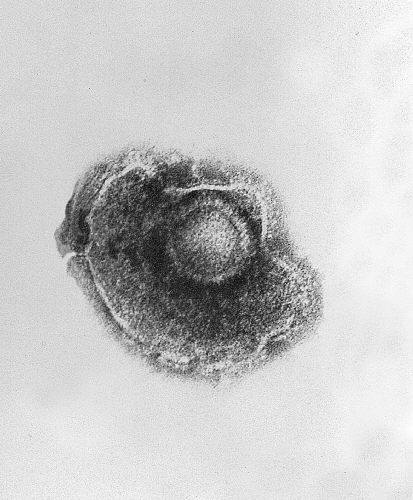Varicella zoster virus
Articles that lack this notice, including many Eduzendium ones, welcome your collaboration! |
Classification
Higher order taxa
Virus Group I, dsDNA, Family Herpesviridae, Genus Varicellovirus, Species Human herpesvirus 3 (HHV-3)
Species
Varicellovirus human herpesvirus 3 (HHV-3)
Description and significance
Varicella Zoster Virus usually comes in two forms. Upon the first infection, it produces red, leathery postules and most often appears in children. This is generally known as "Varicella virus" or chicken pox. If the infection subsequently comes back, it is then typically a painful reddish rash that encompasses most of the body. This form of the disease is known as the "Herpes zoster" or shingles part, and mainly afflicts older people, or those with weakened immune systems. The only known hosts are humans, and people have been reporting cases of Varicella since ancient civilizations. By 1888, but the earliest
Describe the appearance, habitat, etc. of the organism, and why it is important enough to have its genome sequenced. Describe how and where it was isolated.
Include a picture or two (with sources) if you can find them.
Genome structure
Being that it is an alpha herpes virus, The Varicella Virus has a latent period in the root ganglia cells, and then is reactivated as the Herpes Zoster Virus. The virion has a nucleocapsid with a protein covering separating it from the lipid envelope that contains the viral glycoproteins, and a core with a linear, double stranded DNA genome. The infection will bring out the immunoglobulin G, immunoglobulin M, and immunoglobulin A antibodies which will then bind to various viral proteins. [1]
Describe the size and content of the genome. How many chromosomes? Circular or linear? Other interesting features? What is known about its sequence? Does it have any plasmids? Are they important to the organism's lifestyle?
Cell structure and metabolism
Describe any interesting features and/or cell structures; how it gains energy; what important molecules it produces.
Ecology
Describe any interactions with other organisms (included eukaryotes), contributions to the environment, effect on environment, etc.
Pathology
How does this organism cause disease? Human, animal, plant hosts? Virulence factors, as well as patient symptoms.
Application to Biotechnology
Does this organism produce any useful compounds or enzymes? What are they and how are they used?
Current Research
Enter summaries of the most recent research here--at least three required
References
1.Arvin, AM. "Varicella Zoster Virus". Clinical Microbiology Reviews. 1996. Volume 3. p.361-381. [Sample reference] Takai, K., Sugai, A., Itoh, T., and Horikoshi, K. "Palaeococcus ferrophilus gen. nov., sp. nov., a barophilic, hyperthermophilic archaeon from a deep-sea hydrothermal vent chimney". International Journal of Systematic and Evolutionary Microbiology. 2000. Volume 50. p. 489-500.
- ↑ 2
